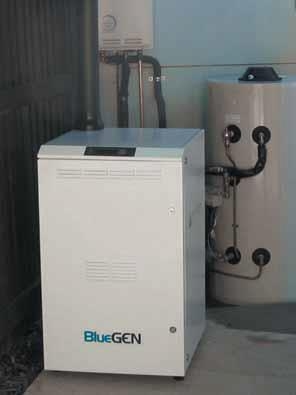Ceramic fuel cells – an alternative ‘green’ solution

With several states in Australia dropping or reducing solar feed-in tariffs and governments continuously changing their policies on the subject, the public’s perception of the solar industry and its view on solar as a viable renewable energy source is increasingly under pressure.
That’s why many electricians and solar installers are looking towards alternative ‘green’ energy products to complement the renewable energy technologies already on offer to these wary customers.
ADVERTISEMENT
For instance, Melbourne-based company Ceramic Fuel Cells Limited (CFCL) has provided a solution in the form of a technology called BlueGen. This unit is around the size of a dishwasher and uses ceramic fuel cells to generate power. For those unfamiliar with the technology, in simple terms, a ceramic fuel cell uses natural gas to generate electricity and heat to be used around the home.
Fuel cells are stacked together inside the BlueGen unit and connected to the natural gas pipeline, hot water and mains power supply. At high temperature, the fuel cells produce electricity through an electro-chemical reaction. The chemistry is similar to a battery as it doesn’t burn the gas, it effectively ‘cracks’ it. However, the unit doesn’t store energy; instead it continuously generates it, providing a constant flow of power.
“For electricians who are already installing green energy products like solar panels and solar hot water, BlueGen is another great offering for their customers,” says CFCL commercial general manager Andrew Neilson.
“We get a lot of enquiries from solar distributors and installers who are worried about the impact that government policy changes are going to have on the industry. There’s not a direct competition between BlueGen and solar; instead they complement each other because you can have BlueGen running 24/7, turning the power up and down, alongside solar and wind generation providing intermittent power.”
BlueGen produces around 1.5kWh of energy at any one time, so it is possible to produce 13,000kWh of electricity a year, which is double the amount of power an average home in Melbourne uses per annum.
Andrew notes that another advantage of the BlueGen system is its efficiency.
“Our peak electrical efficiency is 60%. A brown coal power station has an efficiency of around 28%, and that is before any losses during transmission and distribution – this isn’t a problem with BlueGen, because the power is generated onsite.
“This high efficiency also means additional carbon is saved. In Victoria, the savings equate to around 14 tonnes of carbon a year compared to grid power.”
When installing BlueGen, a trained plumber is needed as well as an electrician, and Andrew says the job is particularly suited to workers already familiar with solar systems.
“BlueGen includes a grid connect inverter, which is AS4777 compliant, so it’s basically the same as installing a solar PV system with an inverter. Any electrician who has Clean Energy Council approval and has completed the relevant training can install it in around half a day.”
According to Andrew, when BlueGen is used in conjunction with other renewable technologies, the technology will really come into its own.
“We have a house in Sydney which has BlueGen working alongside a battery and solar system. There is a whole range of generating technologies, plus onsite storage, which are all operated by a smart controller. This lets the owner avoid peak rates from the grid, and lets you only import during off-peak times.
“Also, in the future, when electric vehicles are more widespread, there will be a demand for car charging methods using low cost power. BlueGen is an ideal way of producing that power onsite.”
-
ADVERTISEMENT
-
ADVERTISEMENT

